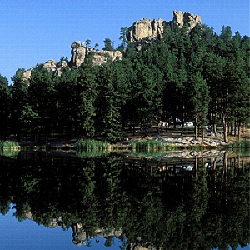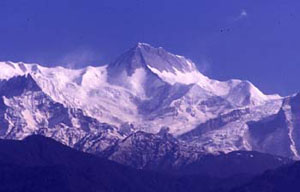
Red Cloud High School
Nature and Spirituality in the Himalayas: A Comparative Approach
| Home |
| Himalayan And Lakota Culture |
| Nature Literature |
| Comparative Mythology |
| Links |
| Bibliography |
| Biography |
Sacred Mountains
The Black Hills-Sylvan Lake Photo courtesy of http://www.blackhillsnewsbureau.com/photos.php
The Himalayas The Lakota consider the Black Hills (Paha Sapa) as their sacred, ancestral world, the heart of everything that is. The majestic Black Hills seem to rise out of nowhere in this Plains landscape. For the Lakota, the Black Hills are the sacred center of the world. Lakota myth states that the first man emerged from Wind Cave, a sight in the Black Hills. There is also a story about a famous, mythical race around the Black Hills between the two-leggeds and four-leggeds, The Lakota traditionally used the Black Hills as a place to pray and conduct religious ceremonies, such as the hanbleceya (vision quest). Some of the most sacred places for the Lakota in the Black Hills are Bear Butte, Devil's Tower, and Harney Peak. In his famous vision, the Lakota spiritual leader Black Elk saw the sacred hoop of the world while standing on top of Harney Peak: "I looked ahead and saw the mountains there with rocks and forests on them, and from the mountains flashed all the colors upward to the heavens. Then I was standing on the highest mountain of them all, [Harney Peak] and round about beneath me was the whole hoop of the world. And while I stood there I saw more than I can tell and I understood more than I saw; for I was seeing in a sacred manner the shapes of all things living in the spirit, and the shape of all shapes as they must live together like one being. And I saw that the sacred hoop of my people was one of many hoops that made one circle, wide as daylight and as starlight, and in the center grew one mighty flowering tree to shelter all the children of one mother and one father. And I saw that it was holy." ~ Black Elk in Black Elk Speaks, pg. 33 The Black Hills were illegally stolen from the Lakota against treaty agreement after gold was discovered there in the 1870s. In 1980, the U.S. Supreme Court granted the Lakota over 105 million dollars to atone for this crime. The Lakota, living in perhaps the poorest conditions in the country, declined the offer, expressing that the Black Hills are not for sale. With collected interest, the money has grown to over 750 million dollars and yet the Lakota still decline the money, seeing acceptance as a compromise of their spiritual and cultural beliefs. Fore more information on the Black Hills, see the following websites: http://www.sacredland.org/historical_sites_pages/black_hills.html http://www.nps.gov/archive/wica/History_of_the_Black_Hills.htm http://www.hanksville.org/daniel/lakota/BlackHills.html Here is the perspective of Delphine Red Shirt, author of Bead on an Anthill: A Lakota Childhood: http://www.dialoguebetweennations.com/n2n/pfii/english/DelphineRedShirt.htm Tim Giago's view: http://friendsonboard.blogspot.com/2007/06/tim-giago-theft-of-sacred-black-hills.html Video: http://www.youtube.com/watch?v=4oq7jpM9u2o
Tibetans also see their surrounding mountains as sacred. For the people in this mountainous region, the Himalayas are sacred, the divine abode of gods. Just as the Lakota see the Black Hills as the sacred center of the world, so too do Tibetan Buddhists perceive the mythical Mount Meru as the center of the cosmos. Mount Kailash is a sacred mountain that is said to be the home of the Hindu god Shiva. It is forbidden for Buddhists to climb Mount Kailash, in respect for its sacredness. Just as there are the rituals of vision quest and prayer ties in the Black Hills, so too do Buddhists perform sacred rituals in the Himalayas. For example, Buddhists meditatively circumambulate the base of Mount Kailash. Both cultures perceive their local mountains not only as sacred, but also as the divine center of the universe. Both cultures perform sacred rituals in these mountains. Move on to Modern Conditions
|

